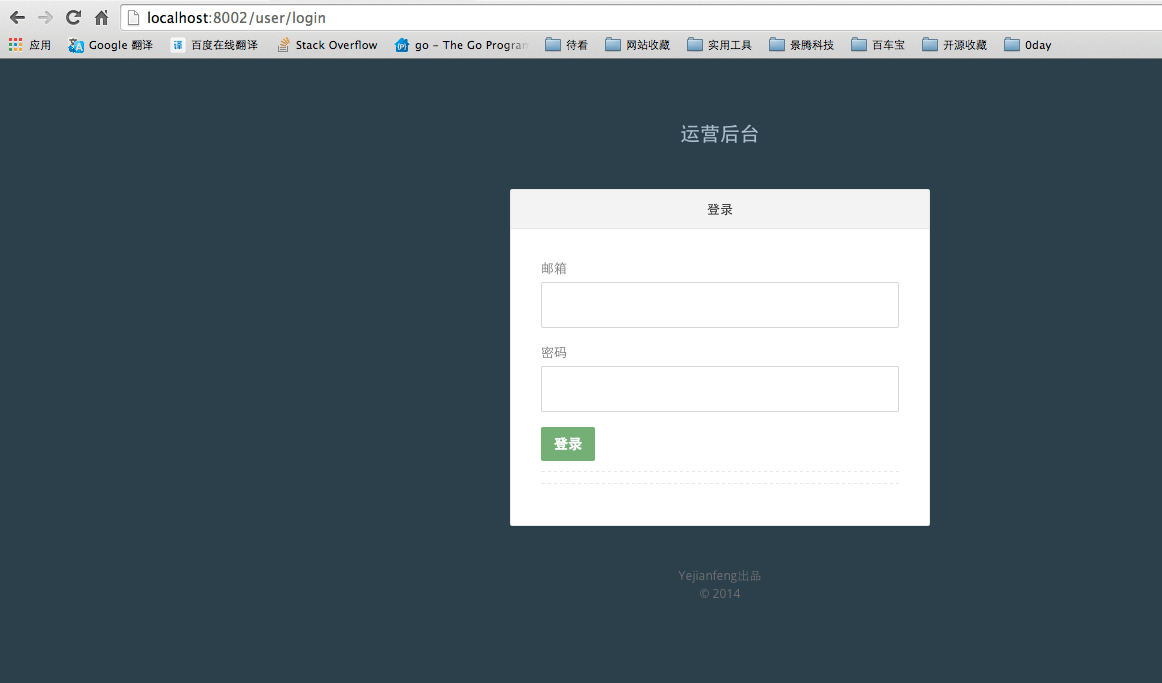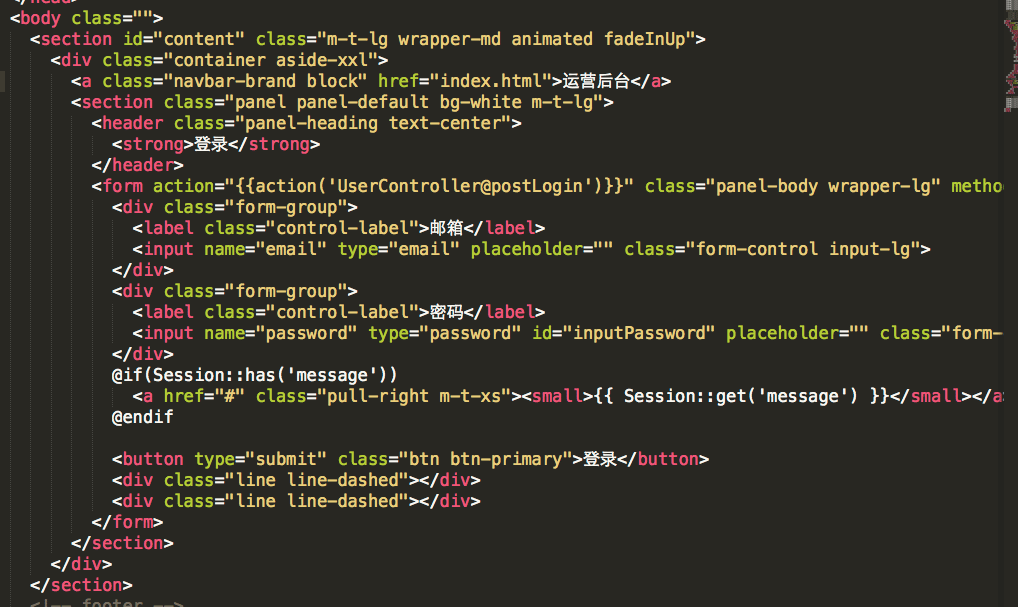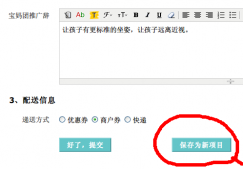本文實(shí)例講述了laravel搭建后臺(tái)登錄系統(tǒng)的方法。分享給大家供大家參考,具體如下:
今天想用laravel搭建一個(gè)后臺(tái)系統(tǒng),就需要最簡(jiǎn)單的那種,有用戶登錄系統(tǒng),試用了下,覺(jué)得laravel的用戶登錄這塊做的還真happy。當(dāng)然,前提就是,你要的用戶管理系統(tǒng)是最簡(jiǎn)單的那種,就是沒(méi)有用戶權(quán)限,能登錄就好。
我這里就不用默認(rèn)的user表做例子了,那樣很容易和laravel的一些默認(rèn)設(shè)置混淆。
首先確認(rèn),后臺(tái)的用戶表,我設(shè)計(jì)表叫做badmin,每個(gè)管理員有用戶名(username),有昵稱(nickname),有郵箱(email),有密碼(password)
這里玩?zhèn)€花,使用laravel的migration來(lái)建立表(實(shí)際上可以用不著使用這個(gè)工具建立表)
1 安裝好最基本的laravel框架
2 創(chuàng)建migration文件:
./artisan migrate:make create-badmin-table
3 發(fā)現(xiàn)app/database/migration/下面多了一個(gè)php文件:
2014_10_19_090336_create-badmin-table.php
4 往up和down里面增加內(nèi)容;
|
1
2
3
4
5
6
7
8
9
10
11
12
13
14
15
16
17
18
19
20
21
22
23
24
25
26
27
28
29
30
31
|
<?phpuse illuminate\database\schema\blueprint;use illuminate\database\migrations\migration;class createbadmintable extends migration { /** * run the migrations. * * @return void */ public function up() { schema::create('badmin', function($table) { $table->increments('id'); $table->string('nickname', 100)->unique(); $table->string('username', 100)->unique(); $table->string('email', 100)->unique(); $table->string('password', 64); $table->timestamps(); }); } /** * reverse the migrations. * * @return void */ public function down() { schema::drop('badmin'); }} |
5 配置好local的database,app/config/local/database.php
|
1
2
3
4
5
6
7
8
9
10
11
12
13
14
15
16
17
18
|
<?phpreturn array( 'fetch' => pdo::fetch_class, 'default' => 'mysql', 'connections' => array( 'mysql' => array( 'driver' => 'mysql', 'host' => 'localhost', 'database' => 'test', 'username' => 'yejianfeng', 'password' => '123456', 'charset' => 'utf8', 'collation' => 'utf8_unicode_ci', 'prefix' => '', ), ), 'migrations' => 'migrations',); |
6 創(chuàng)建數(shù)據(jù)表:
./artisan migrate --env=local
這個(gè)時(shí)候去數(shù)據(jù)庫(kù)看,就發(fā)現(xiàn)多了一張badmin表,數(shù)據(jù)結(jié)構(gòu)如下:
|
1
2
3
4
5
6
7
8
9
10
11
12
13
|
create table `badmin` ( `id` int(10) unsigned not null auto_increment, `nickname` varchar(100) collate utf8_unicode_ci not null, `username` varchar(100) collate utf8_unicode_ci not null, `email` varchar(100) collate utf8_unicode_ci not null, `password` varchar(64) collate utf8_unicode_ci not null, `created_at` timestamp not null default '0000-00-00 00:00:00', `updated_at` timestamp not null default '0000-00-00 00:00:00', primary key (`id`), unique key `badmin_nickname_unique` (`nickname`), unique key `badmin_username_unique` (`username`), unique key `badmin_email_unique` (`email`)) engine=innodb auto_increment=2 default charset=utf8 collate=utf8_unicode_ci; |
要問(wèn)這里為什么多出了create_at和update_at,這是laravel默認(rèn)為每個(gè)表創(chuàng)建的字段,而且在使用eloquent進(jìn)行增刪改查的時(shí)候能自動(dòng)更新這兩個(gè)字段
7 創(chuàng)建個(gè)model:
|
1
2
3
4
5
6
7
8
9
10
11
12
13
14
15
16
|
<?phpuse illuminate\auth\usertrait;use illuminate\auth\userinterface;use illuminate\auth\reminders\remindabletrait;use illuminate\auth\reminders\remindableinterface;class badmin extends eloquent implements userinterface, remindableinterface { use usertrait, remindabletrait; protected $table = 'badmin'; protected $hidden = array('password'); public static $rules = [ 'nickname' => 'required|alpha_num|min:2', 'username' => 'required', 'email'=>'required|email|unique:badmin', 'password'=>'required|alpha_num|between:6,12|confirmed', ];} |
這里必須要implements userinterface和remindableinterface
8 把model和auth關(guān)聯(lián)上,修改app/config/auth.php
|
1
2
3
4
5
6
7
8
|
<?phpreturn array( // 默認(rèn)的用戶驗(yàn)證驅(qū)動(dòng) // 可以是database或者eloquent 'driver' => 'eloquent', // 只有驅(qū)動(dòng)為eloquent的時(shí)候才有用 'model' => 'badmin',); |
這里的driver可以是eloquent或者database,使用eloquent就告訴auth組件說(shuō),用戶認(rèn)證類是badmin這個(gè)類管的。這里的model是有命名空間的,就是說(shuō)如果你的admin類是\yejianfeng\badmin,這里就應(yīng)該改成'\yejianfeng\badmin'
9 好了,這個(gè)時(shí)間其實(shí)邏輯部分已經(jīng)搭建完畢了,你已經(jīng)可以在controller種使用
auth::attempt(xxx) 做權(quán)限認(rèn)證
auth::user() 獲取登錄用戶(一個(gè)badmin類)
等。
10 下面要建立一個(gè)用戶登錄頁(yè)面:

11 設(shè)置路由:
|
1
2
3
4
5
6
7
8
9
10
11
|
<?php// 不需要登錄驗(yàn)證的接口route::get('/', ['as' => 'user.login','uses'=>'usercontroller@getlogin']);route::get('user/login', ['as' => 'login', 'uses' => 'usercontroller@getlogin']);route::post('user/login', ['as' => 'login', 'uses' => 'usercontroller@postlogin']);// 需要登錄驗(yàn)證才能操作的接口route::group(array('before' => 'auth'), function(){ route::get('user/logout', ['as' => 'logout', 'uses' => 'usercontroller@getlogout']); route::get('user/dashboard', ['as' => 'dashboard', 'uses' => 'usercontroller@getdashboard']);}); |
12 設(shè)置controller:
|
1
2
3
4
5
6
7
8
9
10
11
12
13
14
15
16
17
18
19
20
21
22
23
24
25
26
27
28
29
30
31
32
33
34
35
36
37
38
39
40
41
42
43
44
45
46
47
48
49
50
51
|
<?phpclass usercontroller extends basecontroller { // 登錄頁(yè)面 public function getlogin() { return view::make('user.login'); } // 登錄操作 public function postlogin() { if (auth::attempt(array('email'=>input::get('email'), 'password'=>input::get('password')))) { return redirect::to('user/dashboard') ->with('message', '成功登錄'); } else { return redirect::to('user/login') ->with('message', '用戶名密碼不正確') ->withinput(); } } // 登出 public function getlogout() { auth::logout(); return redirect::to('user/login'); } public function getdashboard() { return view::make('user.dashboard'); } // 添加新用戶操作 public function getcreate() { return view::make('user.create'); } // 添加新用戶操作 public function postcreate() { $validator = validator::make(input::all(), user::$rules); if ($validator->passes()){ $badmin = new badmin(); $badmin->nickname = input::get('nickname'); $badmin->username = input::get('username'); $badmin->email = input::get('email'); $user->password = hash::make(input::get('password')); $user->save(); response::json(null); } else { response::json(['message' => '注冊(cè)失敗'], 410); } }} |
13 設(shè)置下filter,app/filter.php
|
1
2
3
4
5
6
7
8
9
10
11
12
13
14
|
route::filter('auth', function(){ if (auth::guest()) { if (request::ajax()) { return response::make('unauthorized', 401); } else { return redirect::guest('/'); } }}); |
將這里認(rèn)證失敗后的地址轉(zhuǎn)到/ 路徑
14 設(shè)置views/user/login.blade.php
這里截取一部分:

可以看出,這里可以直接使用session::has和session::get
然后基本就完成了...
后記
laravel這里的auth機(jī)制還是很方便的,但是migration使用起來(lái)總覺(jué)得有點(diǎn)憋屈。操作數(shù)據(jù)庫(kù)總是隔著一層,不爽。
這里的auth一些簡(jiǎn)單的用戶登錄機(jī)制已經(jīng)可以了,但是如果要做更復(fù)雜的用戶管理權(quán)限,估計(jì)要使用sentry()這樣的第三方組件了。
希望本文所述對(duì)大家基于laravel框架的php程序設(shè)計(jì)有所幫助。














